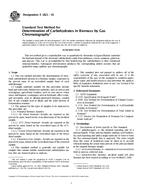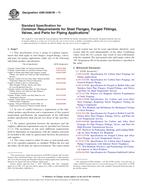1.1 This test method covers a gas chromatographic procedure for the quantitative determination of selected chlorinated acids and other acidic herbicides in water. Similar chemicals may also be determined by this test method, but it is the user’s responsibility to verify the applicability of this test method to any compounds not listed in this scope. The acid form of the following compounds were interlaboratory tested using this test method, and the results were found acceptable:
Analyte Chemical Abstract Services Registry Number Bentazon 25057-89-0 2,4-D 94-75-7 2,4-DB 94-82-6 DCPA acid metabolites 2 Dicamba 1918-00-9 3,5-Dichlorobenzoic acid 51-36-5 Dichlorprop 120-36-5 5-Hydroxydicamba 7600-50-2 Pentachlorophenol (PCP) 87-86-5 Picloram 1918-02-1 2,4,5-T 93-76-5 2,4,5-TP (Silvex) 93-72-1
1.2 This test method may be applicable to the determination of salts and esters of analyte compounds. The form of each acid is not distinguished by this test method. Results are calculated and reported for each listed analyte as the total free acid.
1.3 This test method has been validated in an interlaboratory test for reagent water and finished tap water. The analyst should recognize that precision and bias reported in Section 18 may not be applicable to other waters.
1.4 This test method is restricted to use by or under the supervision of analysts experienced in the use of gas chromatography (GC) and in the interpretation of gas chromatograms. Each analyst must demonstrate the ability to generate acceptable results with this test method using the procedure described in 19.3. It is the user’s responsibility to ensure the validity of this test method for waters of untested matrices.
1.5 Analytes that are not separated chromatographically, that is, which have very similar retention times, cannot be individually identified and measured in the same calibration mixture or water sample unless an alternate technique for identification and quantization exists (16.6, 16.7, and 16.8).
1.6 When this test method is used to analyze unfamiliar samples for any or all of the analytes given in 1.1, analyte identifications must be confirmed by at least one additional qualitative technique.
1.7 This standard does not purport to address all of the safety problems, if any, associated with its use. It is the responsibility of the user of this standard to establish appropriate safety and health practices and determine the applicability of regulatory limitations prior to use. For specific precautionary statements, see Notes 1, 4, and 5, and Section 9.
Product Details
- Published:
- 12/10/1998
- Number of Pages:
- 14
- File Size:
- 1 file , 150 KB


